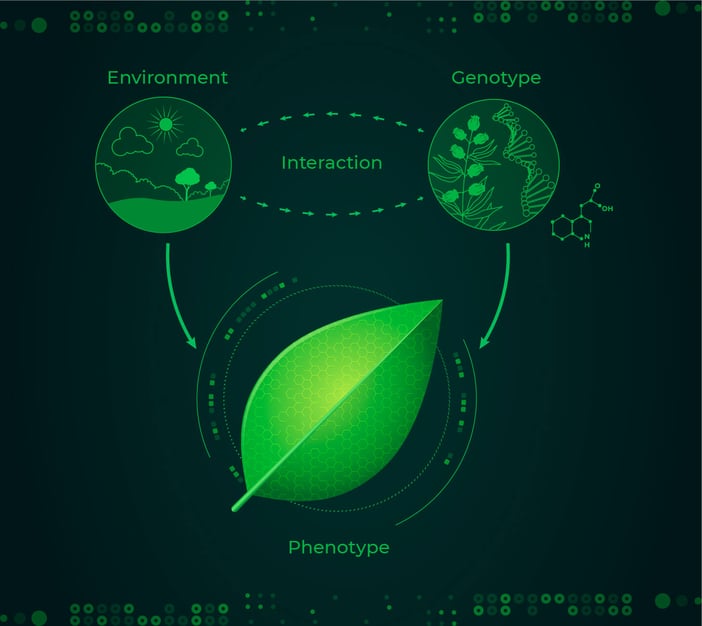Genes play a very crucial role in shaping future generations in living organisms. The basic thought about living beings being patterned creatures is based on their origins. For example, if the offspring from a cricketer plays good cricket, it is assumed to have come from the parent’s cricketing gene. Similarly with plants, the genetic origin speaks volumes about the plant and the future offsprings as well.
Each plant showcases its own characteristics and there are pros and cons in this regard. Maybe the rose plant in your house should have been giving more flowers than what it usually gives. Maybe the bottle gourd should have been bigger in the yield than what you have harvested. Now, what if this could be made true by using genetic material inside the plant and controlling the gene to be the dominantly expressive? This piqued the brains of scientists. And that is how the basic concept of genetic modification in plants and eventually, Phenotyping was introduced.
What Is Phenotyping?
Phenotype is derived from the Greek words ‘phainen’ (to show) and ‘tupos’ (type) and refers to an individual’s collection of measurable characteristics resulting from the genotype’s interaction with the environment; thus, phenotypes represent the organism’s nature and nurture.
Plant phenotyping offers data on the anatomical, historical, physiological and biochemical properties of the plant. Plant phenotyping is a leading factor in the intensity of selection, precision of selection, and new genetic variation detection. Within a plant breeding system, genetic benefit (the amount of increase in output over time) can be accelerated in a variety of ways, including by increasing the size of the breeding program to allow for higher selection intensity.
High-throughput field phenotyping (HTFP) technologies have greatly expanded the capacity for multi-scale tracking and quantification of field experiments and breeding nurseries over the past decade. The advantage of these HTFP technologies is not only to quickly and cost-effectively replace cumbersome and subjective scores, but also to unlock the ability of new, latent phenotypes that reflect the underlying biological function.

Plant breeding becomes inefficient with incorrect phenotyping, and sometimes worthless because any screening of genotypes will be as efficient as its protocol allows, and any bias – as per its magnitude genetic gains can be substantially affected. It is important to understand that the most effective selection is the frequency of favorable alleles in the target population is low in the early breeding cycles.
Any imprecise protocols for phenotyping, particularly in small or finite breeding populations, will reduce efficiency because of the very low frequency of favorable alleles and genetic gains.
Hence, there are different kinds of phenotyping techniques that are implemented based on the farmland and the agenda of application.
High Throughput Field Phenotyping (HTFP)
High Throughput Field Phenotyping uses a wide range of sensors and analysis processes to quantify the efficiency, photosynthesis, production, design, growth or biomass productivity of single plants or plant stands. Originally, some of these sensors and procedures were developed in remote sensing, some in precision farming, while others are laboratory-based imaging procedures. Plant color, spectral reflection, chlorophyll-fluorescence, temperature and other characteristics are quantified, from which characteristics such as biomass, architecture, ear number, photosynthetic ability, stomatal aperture, or resistance to stress can be extracted.
Automated image-based plant phenotyping with high-throughput refers to non-destructively sensing and quantifying plant characteristics by analyzing images collected at regular intervals and with accuracy. While phenomic research has attracted considerable attention in the last decade, the extraction of meaningful and reliable numerical phenotypes from plant images, particularly by taking into account its individual components, e.g. leaves, stem, fruit, and flower, remains a critical bottleneck for the translation of advances in phenotyping technology into genetic insights due to various challenges, including lighting variations.
Proximal Phenotyping
.jpg?width=702&name=Banner%20(1).jpg)
Phenotyping of plants with ground-based vehicles and sensors is known as proximal phenotyping. Proximal phenotyping is an emerging science that associates genomics with agronomy and plant ecophysiology while combining sensor and automated tech. During plant growth and development, the functional plant body (PHENOTYPE) is developed through the complex interaction between the genetic history (GENOTYPE) and the physical environment in which plants develop (ENVIRONMENT). These interactions determine the efficiency and productivity of plants measured as cumulative biomass and the efficiency of commercial yield and resource usage. In order to establish strategies for a sustainable plant, the full spectrum of plant science from molecular to field scale needs to be incorporated.
Phenotyping in Precision Agriculture
There are somewhat different requirements for plant phenotyping for precision agriculture compared to Proximal Phenotyping. Some applications of phenotyping need different approaches and solutions for plant breeding and hence this kind of phenotyping is based on optimizing stable yields and guaranteeing the quality of crops. This kind of phenotyping can be used in early detection of emerging pathogens in plants to bring in timely action. The application of phenotyping is diversified based on specific crops and variants of the crops.
Present high-throughput field phenotyping approaches have promising results that can be used as a framework for growth and enhancement in modern agriculture. Reliable, time and cost-effective phenotyping applications can change the expectation of outputs for farmers if implemented the right way. Agribusinesses and AgTechs must understand how to harness phenotyping and better the yield through sustainable methods. Phenotyping can make wonders when the significant traits of crops are identified and the novel quality of these traits are genetically replicated. This however is a vision for the distant future; nothing that cannot be accomplished. In addition,the phenotypic data produced must be acquired and processed in
a quantitative, stable and in a rapid way of processing, into a format that the end-users will get to interpret it explicitly. The implementation of phenotyping under controlled conditions will prove to be beneficial to both growers and consumers, making it a win-win situation.
To understand more on the capabilities of CropIn’s AI solutions and how they can be implemented as a collaboration with phenotyping, get in touch with our Agri-expert today!









